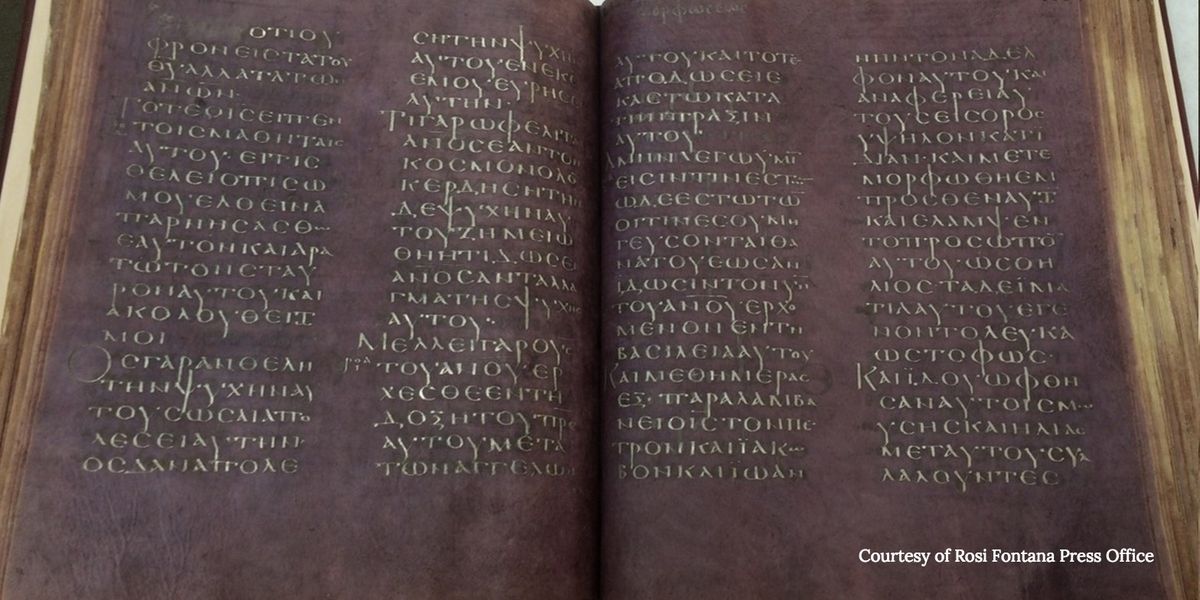Urine-Based Dye Found in Ancient New Testament

Behind one of the oldest surviving illuminated manuscripts of the New Testament lies a mixture of urine and weeds, according to analysis carried out during a lengthy restoration project of the sacred text.
For centuries scholars wondered how the precious purple parchments of the 1,500-year-old Byzantine book known as the Codex Purpureus Rossanensis were obtained.
It was generally assumed that Tyrian purple, extracted from Murex (sea snails) was used to dye the parchment sheets.
RELATED: Cat Paw Prints Found on 15th-Century Manuscript
On the contrary, analysis have shown the mysterious purple resulted from the use of orcein, a natural dye extracted from the lichen Roccella Tinctoria and processed with fermented urine, which at that time was the only source of ammonia.
Included in UNESCO's Memory of the World Register in 2015, the Codex Purpureus Rossanensis was found in 1879 in the sacristy of the Cathedral of Rossano, a town in the Calabria region of southern Italy.
The incomplete manuscript tells the life of Jesus according to the gospels of Matthew and Mark. It was likely made in Syria between the 5th and 6th centuries A.D. and consists of 188 parchment sheets filled with finely executed miniatures and Greek text written in gold and silver ink.
Sign up for the Live Science daily newsletter now
Get the world’s most fascinating discoveries delivered straight to your inbox.
"Most likely, what we have today represents half of the original book," the museum of the diocese of Rossano, where the manuscript returned after the three-year long restoration, said in a statement.
It is believed the two lacking gospels were destroyed during a fire that occurred in the cathedral in the 17th century.
Restorers at the Central Institute for Restoration and Conservation of Archival and Library Heritage (Icrcpal) in Rome led by Maria Luisa Riccardi had to deal with a previous restoration carried out in 1917–19 which irreversibly modified the aspect of the illuminated sheets.
RELATED: mysterious Manuscript's Age Determined
Given the manuscript's frailty, the restorers decided to avoid invasive procedures. They limited the intervention to stitching cuts, tears and small gaps and rather focused on the composition of the codex's pictorial palette.
"Even though early medieval illuminated manuscripts have been deeply studied from the historical standpoint, they have been rarely fully described in their material composition," Marina Bicchieri, director of the Icrcpal's chemistry lab, said.
Since X-ray fluorescence ruled out the presence of bromine, which is characteristic of Tyrian purple, Bicchieri turned to experimental data.
She prepared natural dyes using recipes described in the Stockholm papyrus, a manuscript written in Greek around 300 A.D. which contains 154 recipes for the manufacture of dyes and colors.
"Fibre optics reflectance spectra (FORS) showed a perfect match between the purple parchment of the codex and a dye obtained with orcein and an addition of sodium carbonate," Bicchieri told Discovery News.
RELATED: Gospel of the Lots of Mary' ID'd in Ancient Text
She noted the source for sodium carbonate was likely the mineral natron, a compound similar to table salt that was used by the ancient Egyptians in mummification because of its drying properties.
Raman spectroscopy also revealed that red-mauve or violet shades in the miniatures were obtained using an elderberry-based lake.
"It is the first time that elderberry lake is found in such an ancient illuminated manuscript," Bicchieri said.
Overall, the results show that the same palette was used throughout the entire codex, dismissing claims that vividly colored miniatures such as the one with Mark the Evangelist inspired by the Sophia did not belong to the original book but dated back to the 12th century.
The manuscript is now on display at the Diocesean Museum of Rossano in a temperature and humidity-controlled showcase.
"This codex has an extraordinary historical, artistic and religious significance. It is a symbol for a region like Calabria that reconciled eastern and western civilizations," the museum said.
Original article on Discovery News.











